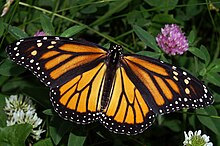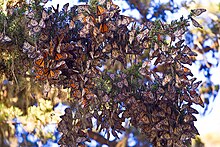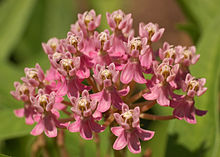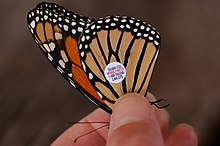
Hi Everybody!!
The Monarch Butterfly Migration is in progress. I went to the garden shop with great anticipation of the hundreds of butterflies that would be there like they were last year. I found ONE! Turns out one is all we need to have a butterfly photo blog tonight. Your photostudy link is below along with info shared in an excerpt from Wikipedia page on Monarchs. Of course, a quick clip from G+Auto BackUp is included. Enjoy!


http://en.wikipedia.org/wiki/Monarch_butterfly
Monarch butterfly
From Wikipedia, the free encyclopedia
The Monarch butterfly (Danaus plexippus) is a milkweed butterfly (subfamily Danainae) in the family Nymphalidae. It is perhaps the best known of all North American butterflies. Since the 19th century, it has been found in New Zealand, and in Australia since 1871, where it is called the wanderer.[3][4][5] It is resident in the Canary Islands, the Azores, and Madeira, and is found as an occasional migrant in Western Europe and a rare migrant in the United Kingdom.[6] Its wings feature an easily recognizable orange and black pattern, with a wingspan of 8.9–10.2 cm (3½–4 in).[7] (The viceroy butterfly is similar in color and pattern, but is markedly smaller, and has an extra black stripe across the hind wing.) Female monarchs have darker veins on their wings, and the males have a spot called the androconium in the center of each hind wing.[8] Males are also slightly larger than female monarchs.
The monarch is famous for its southward late summer/autumn migration from the United States and southern Canada to Mexico and coastal California, and northward return in spring, which occurs over the lifespans of three to four generations of the butterfly. The migration route was fully determined by Canadian entomologists Fred and Norah Urquhartafter a 38-year search, aided by naturalists Kenneth C. Brugger and Catalina Trail who solved the final piece of the puzzle by identifying the butterflies' overwintering sites in Mexico. The discovery has been called the "entomological discovery of the 20th century".[9] An IMAX film, Flight of the Butterflies, tells the story of the long search by the Urquharts, Brugger and Trail to unlock the secret of the butterflies' migration.[10] There is evidence that eastern North American populations of the monarch butterfly migrate to south Florida and Cuba.[11]
| Monarch butterfly | |
|---|---|
 | |
| Female Monarch | |
 | |
| Male Monarch | |
| Conservation status | |
| Scientific classification | |
| Kingdom: | Animalia |
| Phylum: | Arthropoda |
| Class: | Insecta |
| Order: | Lepidoptera |
| Family: | Nymphalidae |
| Tribe: | Danaini |
| Genus: | Danaus Kluk, 1780 |
| Species: | D. plexippus |
| Binomial name | |
| Danaus plexippus (Linnaeus, 1758) | |
 | |
| Synonyms | |
Description[edit]
The monarch’s wingspan ranges from 8.9–10.2 cm (3½–4 in).[7] The upper side of thewings is tawny-orange, the veins and margins are black, and in the margins are two series of small white spots. The fore wings also have a few orange spots near the tip. The underside is similar, but the tip of the fore wing and hind wing are yellow-brown instead of tawny-orange and the white spots are larger.[20]
The male has a black patch of androconial scales on either hind wing (in some butterflies, these patches disperse pheromones, but are not known to do so in monarchs), and the black veins on its wing are narrower than the female’s. The male is also slightly larger.[20]
A color variation has been observed in Australia, New Zealand, Indonesia and the United States as early as the late 19th century. Named nivosus by lepidopterists, it is grayish-white in all areas of the wings that are normally orange. Generally, it is only about 1% or less of all monarchs, but has maintained populations as high as 10% on Oahu in Hawaii, possibly due to selective predation.[21]
Like all insects, the monarch has six legs, but uses the four hindlegs as it carries its two front legs against its body.[22]
The eggs are creamy white and later turn pale yellow. They are elongated and subconical, with about 23 longitudinal ridges and many fine traverse lines.[20] A single egg weighs about 0.46 mg (0.0071 gr), and measures about 1.2 mm (47 mils) high and 0.9 mm (35 mils) wide.[23][24]
The caterpillar is banded with yellow, black, and white stripes. The head is also striped with yellow and black. Two pairs of black filaments are seen, one pair on each end of the body. The caterpillar reaches a length of 5 cm (2 in).[25]
The chrysalis is blue-green with a band of black and gold on the end of the abdomen. Other gold spots occur on the thorax, the wing bases, and the eyes.[26]
Range and distribution[edit]
In North America, the monarch ranges from southern Canada to northern South America. It rarely strays to western Europe (rarely as far as Greece) from being transported by US ships or by flying there if weather and wind conditions are right. It has also been found in Bermuda, Hawaii, the Solomons, New Caledonia, New Zealand, Australia, New Guinea, Ceylon, India, the Azores, and the Canary Islands.[26]
Migration[edit]
Monarchs are especially noted for their yearly migration over long distances. In North America they make massive southward migrations starting in August until the first frost. There is a northward migration in the spring.[27] The monarch is the only North American butterfly that migrates both north and south as the birds do regularly, but no individual makes the entire round trip. Female monarchs lay eggs for the next generation during these migrations.[28] Painted Ladiesalso make a return migration from Africa to Northern Europe [29]
By the end of October, the population east of the Rocky Mountains migrates to thesanctuaries of the Mariposa Monarca Biosphere Reserve within the Trans-Mexican Volcanic Belt pine-oak forests in the Mexican states of Michoacán and México. The western population overwinters in various coastal sites in central and southern California,United States, notably in Pacific Grove, Santa Cruz, and Grover Beach.
The length of these journeys exceeds the normal lifespan of most monarchs, which is less than two months for butterflies born in early summer. The last generation of the summer enters into a nonreproductive phase known as diapause, which may last seven months or more.[8] During diapause, butterflies fly to one of many overwintering sites. The overwintering generation generally does not reproduce until it leaves the overwintering site sometime in February and March.
The overwintered population of those east of the Rockies may reach as far north as Texasand Oklahoma during the spring migration. The second, third and fourth generations return to their northern locations in the United States and Canada in the spring. How the species manages to return to the same overwintering spots over a gap of several generations is still a subject of research; the flight patterns appear to be inherited, based on a combination of the position of the sun in the sky[30] and a time-compensated Sun compass that depends upon a circadian clock based in their antennae.[31][32] New research has also shown these butterflies can use the earth's magnetic field for orientation. The antennae contain cryptochrome, a photoreceptor protein sensitive to the violet-blue part of the spectrum. In presence of violet or blue light, it can function as a chemical compass, which tells the animal if it is aligned with the earth's magnetic field, but it cannot tell the difference between magnetic north or south. The complete magnetic sense is present in a single antenna.[33][34]
Monarch butterflies are one of the few insects that can cross the Atlantic. They are becoming more common in Bermuda, due to increased use of milkweed as an ornamental plant in flower gardens. Monarch butterflies born in Bermuda remain year round due to the island's mild climate. A few monarchs turn up in the far southwest of Great Britain in years when the wind conditions are right, and have been seen as far east as Long Bennington in Lincolnshire. In Australia, monarchs make limited migrations in cooler areas,[3] but the blue tiger butterfly is better known in Australia for its lengthy migration.[4] Monarchs can also be found in New Zealand. On the islands of Hawaii, no migrations have been noted.
Monarch butterflies are poisonous or distasteful to birds and mammals because of the presence of the cardiac glycosides contained in milkweed eaten by the larvae. The bright colors of larvae and adults are thought to function as warning colors. During hibernation, monarch butterflies sometimes suffer losses because hungry birds pick through them looking for the butterflies with the least amount of poison, but in the process kill those they reject.
One study examined wing colors of migrating monarchs using computer image analysis, and found migrants had darker orange (reddish-colored) wings than breeding monarchs.[35]
Research also has overturned a prevailing theory that the migration patterns of the eastern and western populations are due to genetic reasons and that their genetic material was different. The American populations have been found to be distinct from the populations in New Zealand and Hawaii, but not from each other.[36]
Pictorial lifecycle[edit]
Defense against predators[edit]
In both caterpillar and butterfly form, monarchs use a bright display of contrasting colors to warn potential predators of its undesirable taste and poisonous characteristics. Thisaposematic behavior is common among many insects, amphibians, and mammals alike. Additionally, monarchs are physically similar to the viceroy butterfly, exhibiting a classic case of mimicry.
Aposematism
Monarchs are foul-tasting and poisonous due to the presence of cardenolide aglycones in their bodies, which the caterpillars ingest as they feed on milkweed.[39] By ingesting a large amount of plants in the genus Asclepias, primarily milkweed, monarch caterpillars are able to sequester cardiac glycosides, or more specifically cardenolides, which are steroids that act in heart-arresting ways similar to digitalis.[47] It has been found that monarchs are able to sequester cardenolides most effectively from plants of intermediate cardenolide content rather than those of high or low content.[48]
Additional studies have shown that different species of milkweed have differing effects on growth, virulence, and transmission of parasites.[49] One specific species (Asclepias curassavica) appears to reduce the proportion of monarchs infected by parasites. There are two possible explanations for the positive role of A. curassavica on the monarch caterpillar. The first is that A. curassavica promotes overall monarch health to boost the monarch’s immune system. A second theory is that A. curassavica has a direct negative effect on the parasites.[49]
After the caterpillar becomes a butterfly, the toxin shift to different parts of the body. Since many birds attack the wings of the butterfly, having three times the cardiac glycosides in the wings leaves predators with a very foul taste, and may prevent them from ever ingesting the body of the butterfly.[47]In order to combat predators that remove the wings only to ingest the abdomen, monarchs keep the most potent cardiac glycosides in their abdomens.[50]
Monarch toxins are pharmacologically similar to digitalis and produce extremely similar results in experimental settings.[47] In the wild, the toxins cause many birds to experience intense discomfort and vomiting. Many birds find monarchs unappetizing and quickly begin recognizing their distinct colors and avoiding them as food sources.
Mimicry
Monarchs share the defense of noxious taste with the similar-appearing viceroy butterfly in what is perhaps one of the most well-known examples of mimicry. Though long purported to be an example of Batesian mimicry, the viceroy is actually reportedly more unpalatable than the monarch, making this a case of Müllerian mimicry.[51]
Relationship with humans[edit]
The monarch is the state insect of Alabama,[52] Idaho,[53] Illinois,[54] Minnesota,[55]Texas,[56] and the state butterfly of Vermont[57] and West Virginia.[58] It was nominated in 1990 as the national insect of the United States of America, along with the honeybee (Apis mellifera),[59] but the legislation did not pass.[60]
Many people like to attract monarchs by growing a butterfly garden with a specific milkweed species. Others enjoy raising them for pleasure or for educational purposes. For migrating flocks, sanctuaries have been created at favorite wintering locations,[61] and these migrations can generate significant tourism revenue.
Many schools also enjoy growing and attending to monarch butterflies, starting with the caterpillar form. When the butterflies reach adulthood, they are then released into the wild.[62]
Some organizations, such as the Cape May Bird Observatory, have monarch identification tagging programs. Plastic stickers are placed on the wing of the insect with identification information. Tracking information is used to study their migration patterns, including how far and where they fly.[63]



Your butterfly photostudy is located in my G+ Photo Album Gallery with a slideshow option at the link below:
link:https://plus.google.com/photos/117645114459863049265/albums/5939057126558574273
Highlights for this album created by G+ AutoBackUp-----AWESOME!


...this is brendasue signing off from Rainbow Creek. See You next time! Photograph your butterflies!

O+O





























No comments:
Post a Comment
Hi Everybody! Please say hello and follow so I know you are here! Due to the inconsideration of people trying to put commercials on my blog comment area, I have restricted use of anonymous posts. Sorry that some hurt all.
My public email is katescabin@gmail.com No spammers or trolls